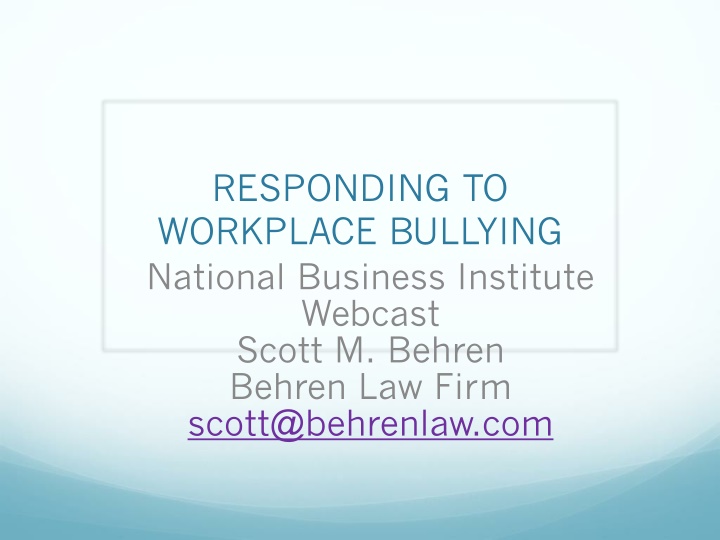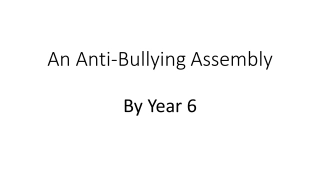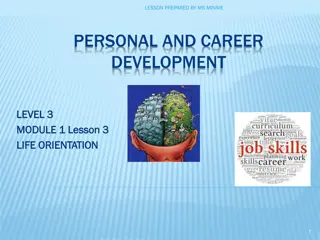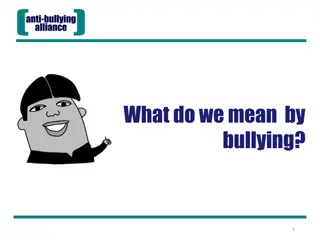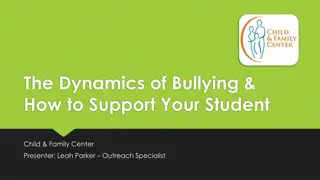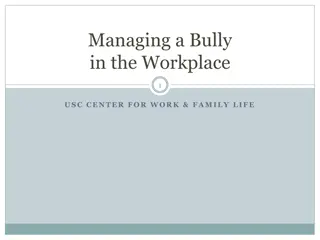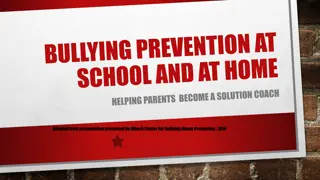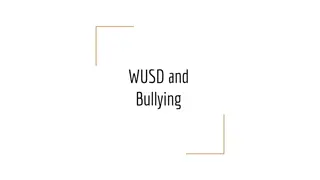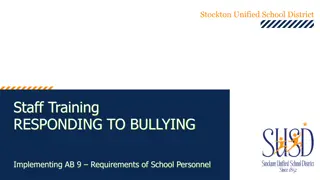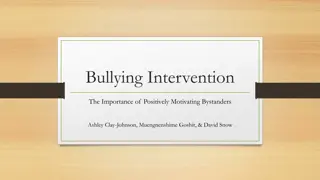Addressing Workplace Bullying: Facts, Effects, and Solutions
Workplace bullying is a prevalent issue that can lead to detrimental effects on employees and employers alike. Defined as unwelcome behavior meant to harm those who feel powerless, bullying can result in physical, emotional distress, and decreased productivity. Employers need to implement policies, such as those outlined by OSHA, to prevent and address workplace bullying effectively, ensuring a safe and respectful work environment for all.
Download Presentation

Please find below an Image/Link to download the presentation.
The content on the website is provided AS IS for your information and personal use only. It may not be sold, licensed, or shared on other websites without obtaining consent from the author.If you encounter any issues during the download, it is possible that the publisher has removed the file from their server.
You are allowed to download the files provided on this website for personal or commercial use, subject to the condition that they are used lawfully. All files are the property of their respective owners.
The content on the website is provided AS IS for your information and personal use only. It may not be sold, licensed, or shared on other websites without obtaining consent from the author.
E N D
Presentation Transcript
RESPONDING TO WORKPLACE BULLYING National Business Institute Webcast Scott M. Behren Behren Law Firm scott@behrenlaw.com
What is Bullying Bullying is generally defined as unwelcome behavior that occurs over a period of time and is meant to harm someone who feels powerless to respond. Verbal bullying includes teasing and threatening to cause harm, according to stopbullying.gov, a website managed by the U.S. Department of Health and Human Services.
What is Bullying The Centers for Disease Control and Prevention ( CDC ) regards bullying as a serious problem to national health in America. The CDC reports that Bullying can result in physical injury, social and emotional distress, and even death.
What is Bullying According to a 2014 national survey conducted by Zogby International and the Workplace Bullying Institute: 27% of workers have experienced bullying in the workplace 72% of employers who have received bullying complaints ignored the problem or made it worse 56% of workplace bullies were supervisors
Bullying Effects on Employers Low morale for employees Low productivity for employees Increased chances of workplace violence Increased absenteeism Can lead to employee health issues such as anxiety
OSHA Policies OSHA Field Safety and Health Manual-Chapter 10 Violence in the Workplace Purpose is provide a workplace free from violence, harassment, intimidation and other disruptive behavior Includes assault, intimidating behavior, threats and workplace violence
OSHA Policies Employees will treat all other employees, as well as customers, with dignity and respect. Management will provide a working environment as safe as possible by having preventative measures in place and by dealing immediately with threatening or potentially violent situations. No employee will engage in threats, violent outbursts, intimidation, bullying, harassment, or other abusive or disruptive behaviors.
Bullying Claims:How they Fit Under Existing Federal Laws There is no federal law that prohibits bullying A Claim that includes workplace bullying may be actionable as a hostile work place claim or Title VII claim, but the actions taken against employee must be because the employees is member of a legally protected group based upon age, sex, disability, religion, national origin, etc. Looking at case-law, most federal courts have not permitted bullying claims to be actionable
State-Anti-Bullying Policies More than two dozen states have introduced workplace anti-bullying laws, but few have passed to date. Aware of four states that have passed laws, Tenn, Utah, North Dakota and California.
State-Anti-Bullying Policies Healthy Workplace Bill Proposed legislation to be passed by states Provides employees with redress for workplace bullying Holds the employer accountable Compels employers to prevent and correct conduct
State-Anti-Bullying Policies Healthy Workplace Bill Protections for employer Defines abusive work environment Protects employers from actions if they have a prevention and correction policy in place
State-Anti-Bullying Policies Tennesee passed Healthy Workplace Act in 2014 that applied to public employers and was expanded to private employers in April 2019. However, does not provide cause of action against employers. Merely immunizes employers from claims of employees if they have a prevention policy that (1) help employers recognize and respond to abusive conduct at work, and (2) prevent retaliation against employees who report any abusive conduct.
State-Anti-Bullying Policies 2016 UT Legislative Progress Utah was the 14th state to introduce the Healthy Workplace Bill Utah was 3rd to pass a state law related to workplace abusive conduct (2015) Sen. Alvin Jackson introduced SB 214, Workplace Abusive Conduct Amendments This bill modifies the definitions of "retaliatory action" and "adverse action" to include engaging in abusive conduct; and prohibits an employer from taking adverse action against an employee if the employee reports abusive conduct. It is an extension of protections for government employees under the state whistleblower law.
State-Anti-Bullying Policies North Dakota Each state agency, department, and institution shall adopt and enforce a policy on employee harassment, including sexual harassment. The policy must clearly define harassment and specify the responsibilities of the employee, supervisor, and the agency, department, or institution. If an agency, department, or institution does not adopt a harassment policy, the agency, department, or institution must be subject to the policy adopted by the North Dakota human resource management services division. The text above is now encoded in State Law: Sec. 54-06-038 of the North Dakota Century Code.
State-Anti-Bullying Policies California-Workplace bullying is NOT actually illegal in California. There is no California statute allowing employees to sue their employers and/or coworkers over cases of bullying at work. However, a 2014 California law called AB 2053 does require California employers with 50 or more employees to provide training to supervisors every two years that includes training on prevention of "abusive conduct" (meaning workplace bullying). (This training is to be provided along with sexual harassment prevention training that employers are required to provide as part of their strategy to prevent harassment in the workplace.) Also, employees who are victims of workplace bullying may have a legal right to compensation if the bullying crosses the line into workplace harassment.
Bullying and Discrimination and Harassment Claims Again, in most states there are no bullying claims that will stand on their own. In many instances, bullying claims may overlap with discrimination and harassment and or whistleblowing claims so long as the bullying is premised upon a protected trait such as religion, gender, national origin, disability, etc.
Creating Anti-Bullying Policies Set a no tolerance policy that sets forth consequences for any bullying Make sure to present the policy to all employees Promote anti-bullying training for both managers and other employees Make sure there is an HR or other contact for employees to reach out to if there is bullying Set out in writing a process to follow when complaints are made of bullying
Creating Anti-Bullying Policies Introduction Employer is committed to creating and maintaining a work place environment which fosters mutual respect, integrity and professional conduct. In keeping with this policy the company has established this Policy as a procedure for all employees relating to the issue of workplace bullying and harassment. The Company will not tolerate bullying or harassment in the workplace and will make every reasonable effort to prevent and eliminate conduct which falls within the scope of this Policy.
Bullying and harassment -includes any inappropriate conduct or comments by a person toward a worker that the person knew or reasonably ought to have known would cause that worker to be humiliated or intimidated, but -excludes any reasonable action taken by an employer or supervisor relating to the management and director of workers or the place of employment -Bullying and harassment are often characterized through insulting hurtful, hostile, vindictive, cruel or malicious behaviors which undermine, disrupt or negatively impact another s ability to do this or her job and results in a harmful work environment for the employee.
Creating Anti-Bullying Policies Bullying may be the result of deliberate intention or not. It is important to recognize that it is the impact of the behavior on others, not the intent, which determines whether or not the bullying has occurred. Depending upon the severity and impact of the behavior, a single significant incident may constitute bullying, if if is found to be sufficiently offensive, threatening or intimidating. To determine whether or not bullying has occurred , each situation must be examined reasonably and objectively based upon specific facts.
Creating Anti-Bullying Policies Examples of conduct which might constitute bullying and harassment include: -verbal, written or physical threats and intimidation -insulting or derogatory remarks, gestures or actions -shouting, yelling Swearing and calling someone derogatory names -targeting an individual through persistent unwanted criticism Public ridicule
Creating Anti-Bullying Policies Vandalizing personal belongings Spreading malicious rumors, gossip, or negative innuendo
Creating Anti-Bullying Policies EMPLOYEE s RIGHTS, ROLES AND RESPONSIBILITIES Each and every employee of the Company is expected to support the implementation of this Policy by: Conducting themselves in a manner which demonstrates professional conduct, mutual respect for others and which honors diversity in the workplace Not engaging in the bullying and harassment of others
Creating Anti-Bullying Policies -participating fully and in good faith in any resolution process or formal complaint and investigation process where they have been identified as having potentially relevant information; -reporting any bullying and harassing behaviors which they experience or observe in the workplace which may be in violation of this Policy; and Respecting the rights to personal dignity, privacy and confidentiality pertaining to this Policy
Creating Anti-Bullying Policies MANAGEMENT ROLES AND RESPONSIBILITIES While every employee is responsible maintaining and contributing to an environment which is free from bullying, those in positions of authority over staff carry more responsibility than other employees within the Company s organization. Management personnel have additional obligations to make every reasonable effort to establish and maintain a workplace free or bullying and harassment.
Creating Anti-Bullying Policies Related to this policy, their responsibilities include but are not limited to: Ensuring that employees have full access to information regarding employer policies and standards Respecting the rights of all parties to a fair, equitable and confidential process for responding to complaints Providing support to all those who participate in a problem solving process and Enforcement of corrective and/or disciplinary measures where applicable
Relevant Case-Law Cases Helpful to Claims of Bullying in Workplace
Relevant Case-Law Tina Bruce v. Levy Premium Foodservices Limited Partnership of Tenn, 324 F .Supp.3d 962 (M.D. Tenn. 2018) Held some of the conduct Bruce was terminated over including bullying could be interpreted as perpetuating gender stereotypes. Sex stereotyping can include an employer who acts on belief that a woman cannot be aggressive
Relevant Case-Law Christopher Seehawer v. McMinnville Water & Light, Case No: 16-cv-01682-AC (D.C. Oregon 3/15/19) Bullying conduct that is not facially sex specific may violate Title VII Where a male supervisor engaged in shouting in a a loud and hostile manner, used profanity, and was intimidating toward female employees this could satisfy the Title VII because of sex requirements
Relevant Case-Law EEOC v. National Educ. Assn Alaska, 422 F .3d 840 (9thCir 2005) A pattern of abuse in the workplace directed at women whether or not motivated by lust or a desire to drive women out of the organization can violate Title VII. This case illustrates where an abusive bully takes advantage of a traditionally female workplace because he is more comfortable when bullying women then bullying men.
Relevant Case-Law Bryant Junco v. Adventist Health Care System, Case No: 17-22364-CIV-COOKE/Goodman (S.D. Fla. 9/24/18) Motion to Dismiss denied where employee alleged hostile work environment based upon bullying, being mocked and harassed for being only male secretary and claiming that he must be homosexual Denied Motion to Dismiss holding Complaint stated claims for Title VII violations
Relevant Case-Law Cases Not Helpful to Workplace Bullying Claims
Relevant Case-Law Wallace Borski v. Staten Island Rapid Transit, Case No: 09-4916 (2ndCir 3/16/11) Denial of leave to amend based upon futility would have been futile for the district court to permit Borski to raise his hostile work environment claim because workplace bullying, such as the behavior exhibited by Borski s colleagues in this case, does not constitute discrimination merely because it contains sexual content or connotations
Relevant Case-Law Jesus Acosta v. East Penn Manufacturing Company, Inc., Case No: 14-1859 (E.D. Pa. 9/30/15). Employee brought claim under Title VII for racial remarks and workplace bullying Summary judgment entered where there was no evidence that the employee s workplace bullying was attributable to his race and therefore he did not satisfy the first prong of a hostile work environment test.
Relevant Case-Law Walter Hawkins v. David Hidalgo, 2019 NY Slip Op 33232 (U) (S.C. N.Y. 10/30/19) Claims brought under NY whistleblower act claiming that complaints about bullying resulted in termination Trial Court granted Motion to Dismiss. bullying without more does not rise to the level of a violation of law, rule or regulation.
Relevant Case-Law Ashman Jaber v. Firstmerit Corp., 81 N.E.3d 879 (Ohio App. 2017) Employee brings claim for wrongful discharge in violation of public policy based upon workplace bullying Brought under Ohio statute that prohibits termination based upon violation of public policy Court held no public policy against workplace bullying in Oh. Employment laws not general civility code
Relevant Case-Law Rosemarie Vito v. Bausch & Lomb Incorporated, Case No; 10-756-cv (2ndCirc. 12/17/10) Many of the incidents Vito claims demonstrate a hostile work environment amount to, at most, workplace bullying completely detached from any discriminatory motive. Affirmed summary judgment of trial court
Relevant Case-Law Kathleen McKay v. The Medical University of South Carolina, Case No: 2:17-45-RMG (D. S.C., 2017) workplace bullying and ridicule, standing alone, are not FMLA violations
Relevant Case-Law Fred L. Nance v. NBCUniversal Media, LLC, Case No: 16-11635 (N.D. Ill. 4/12/18) Employee brought hostile work environment based upon conflicts and general bullying but fails to allege a connection between his harassment and his race. Held no hostile work environment and dismissed this count of Complaint
Relevant Case-Law Kervin Jeanty v. Precision Pipeline Solutions, LLC, Case No 18CV7721 (S.D.N.Y. 8/2/19) Even if mean-spiritedness or bullying renders a workplace environment abusive, there is no violation of the law unless that mean-spiritedness or bullying is rooted in discrimination based on a protected characteristic Title VII does not set forth a general civility code for the American workplace
Relevant Case-Law Christina K. Connearney v. Main Line Hospitals, Inc., Case No: 15-02730 (E.D. Pa. 12/22/15) Court held that there is no common law cause of action against bullying Court refused to create a common law action against bullying in workplace
Relevant Case-Law Cecilia Catherin Mack v. Paris Maintenance Co, Inc., 14cv6955-GBD-FM (S.D.N.Y. 2/22/16) Employee brought hostile work environment claim. mere workplace bullying is not enough to give rise to an actionable hostile work environment claim. Rather, there must be a showing that the conduct occurred because of the employee s membership in a protected class
Relevant Case-Law Wanda Williams v. New York City Dept of Education, 17-cv-1996 (S.D.N.Y. 9/29/18) Mere workplace bullying is not enough to give rise to an actionable hostile work environment claim. Rather there must be a showing that the conduct occurred because of the employees membership in a protected class.
Relevant Case-Law Tameka Barnes v. Nationwide Mutual Insurance Company, Case No: 14-1771 (3rdCir. 1/23/15) Bullying or discrimination of any kind in the workplace is wrong, but not every wrong is a violation of federal law.
Relevant Case-Law Christian R. Evert v. Wyoming County Community Health System, 14-CV-912 (W.D.N.Y. 5/4/17) Bullying and harassment have no place in the workplace, but unless they are motivated by the victims membership in a protected class, they do not provide a basis for an action under Title VII the Court does not condone bullying, but it cannot read Title VII to protects its victims unless the bullying reflects discrimination based upon race, color, religion, sex or national origin.
Relevant Case-law Brenda Ganheart v. Charles Brown, Case No: 17-43 (E.D. La. 7/24/17) Employee did not plead sufficient facts to establish hostile work environment. At best employee raised non-specific allegations of bullying and close supervision and do not contain sufficient factual details to plausibly allege a hostile work environment claim.
Relevant Case-Law Blair Davis-Garett v. Urban Outfitters, Inc., 15-CV- 09598 (S.D. N.Y. 9/27/17) Mere bullying is not enough to make a hostile work environment. Courts look at frequency of conduct, its severity, whether its physically threatening or humiliating or a mere offensive utterance and whether it interferes with employees job performance
Resources www.workplacebullying.org- workplace bullying institute www.donothate.org- Do Not Hate Foundation www.healthyworkplacebill.org site with summary of the features of Healthy Workplace Bill www.stopbullying.gov www.abusergoestowork.com
